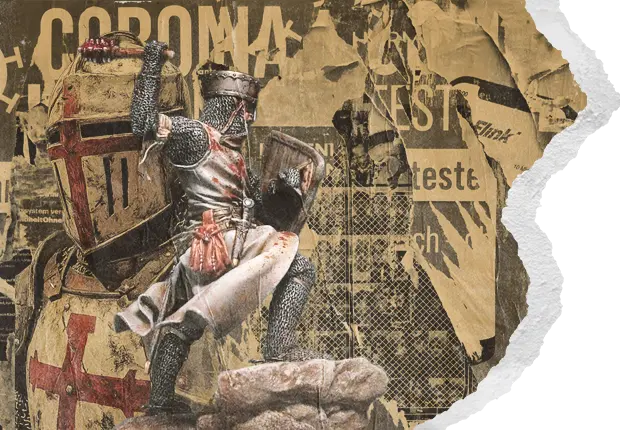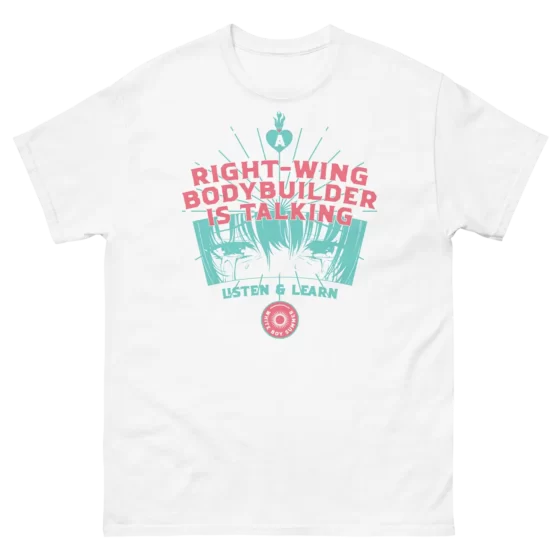On Becoming a Crusader
Long have I deemed “Judeo-Christian” a weasel word. “Judeo-Christian identity” or “Judeo-Christian values” are terms deployed by cuckservative politicians to distract their more right-leaning useful idiot supporters. Amid some argument for free-speech absolutism, or transgressive anti-morality, or economic libertarianism, or deracinating individualism, they drop in the term “Judeo-Christian” to befuddle their listeners, who then think that tradition is being upheld when in fact whatever’s left of tradition is what’s being deconstructed.
Admittedly, though, “Judeo-Christian”, for all its obfuscatory power, nonetheless has some rhetorical power with which I tentatively sympathise, because it signals that there are two looming problems that the West faces: secularisation and Islamification, which are correlated problems—the obviousness of which only requires a few seconds of thought to become apparent. By dropping in the term “Judeo-Christian”, one can allude to these problems without naming them, for doing so could be politically disastrous. Indeed, under Keir Starmer’s regime in the UK, naming these problems could elicit a visit from the police.
But they are problems, and we need to fess up to them. Walk into almost any gym in the UK and you will see a disproportionate number of Muslim men lifting heavy weights. They speak in their own language, or they speak in a kind of corrupted English that is intelligible to them alone, and many have a single bruise on their foreheads to indicate to others their piety. They train often, and supposedly they train for a purpose. If appearances are to be believed, they train for battle.
They are prudent to do so. The so-called ‘vibe shift’ to the political right may make things complicated for a well-organised and partially militarised Muslim presence in the West. Moreover, the veil has recently been pulled back to reveal decades of rape and torture of children and vulnerable young English adults by Muslim gangs in towns and cities throughout this ancient kingdom. A subterranean wrath now bubbles under the lethargy and defeatism of the English, and with a little imported American self-confidence—which is certainly on its way—things could get rocky, and fast.
A secularised Britain will never respond to the maladies that afflict it, for a defence of nothingness is inherently weak. But secularism seems to be waning. Those men of ancient Albion who followed the Lionheart into the desert to recover the Kingdom of Jerusalem may awake from their slumber; and what will the liberal powerholders of our current post-historical Britain do then? There are only so many prison cells for impassioned patriots on this little island.
Edmund Burke, in his seldom read 1757 work An Abridgment of English History, traces the slow transformation from the 5th to the 7th centuries of the Anglo-Saxon warlord into the high-medieval knight. This transformation, Burke convincingly argues, was wrought by the growing presence of monasticism in these isles during that period. The knight, to the embarrassment of internet neo-Nietzscheans, was not the embodiment of cringing slave-morality. The knight was an armoured god, a hunter of men, a dreaded force of righteousness. The knight was the terror of all enemies of Christian civilisation.
We cannot go back to the Anglo-Saxon pagan warlord, and nor should we want to. Christian civilisation is our birthright, and that is what must be defended against the materialism, nihilism, and effeminacy of modernity, without which an Islamic ascendency in the nations of the West would have been impossible. One who trains for vanity, who trains for the “beach body,” will have nothing to offer in defence of his civilisation. Such a man is a nothingness coated in useless bulk. Such was not Charles Martel who scattered the Saracen raiders at Poitiers, nor Godfrey de Bouillon who led the knights of the West into the East and founded the crusader kingdom, nor Jan Sobieski who trampled the Turk at Vienna as he led the largest cavalry charge in history.
These men were Christian knights, and they knew exactly what civilisation they were defending. When they trained, they trained as a form of kenosis—of self-forgetfulness. They sought not the vanity of the “authentic self,” but rather pursued self-negation, that they might throw themselves into the arena of death, offering themselves as an oblation for the continuation of their people. In other words, these men were thoroughly unmodern. We cannot produce such men today, because we do not know what we train for. But our newly arrived friends from the tumultuous deserts beyond the borders of old Christendom, who train daily to become strong and dangerous, know exactly what they’re training for.
The French knight Jean II Le Maingre “Boucicaut” (1366-1421)—widely deemed the very personification of chivalry, and a knight perhaps unequalled in the number of his campaigns—had this said about him in a biography written during his lifetime:
“He would train for hours with a battle-axe or a hammer to harden himself to armour and to exercise his arms and hands, so that he could easily raise his arms when fully armed. Doing such exercises gave him a physique so strong that there was no other gentleman in his time who was so proficient—for he could do a somersault fully armed but for his bascinet, and he could dance equipped in a coat of mail.”
That is how we should train. We should train like knights. We should train like men who train for battle, who have a purpose, a civilisation to defend, and a people whom they call their own.
All that should be conserved in our civilisation is downstream from Christianity. Our art, our architecture, our music, our legal systems, our social structures, our academic ventures, our sense of history, our agriculture, our connection with nature though hunting, foraging, and gardening—all is gifted by Christianity or conditioned by Christianity. And hence we should train like defenders of Christian civilisation. Anyone thinking he can do this as a neo-pagan vitalist or a neo-viking is a LARPer who is just as implicated in the deconstruction and defeat of the West as any neoliberal cuckservative.
Like Boucicaut, you should “train for hours with a battle-axe or a hammer to harden” yourself. This is what American MMA fighters in the noughties discovered that Indian wrestlers had been doing for millennia. By swinging the gada, or mace as we would call it, until their core stabilising muscles were like rocks and their shoulders like boulders, Indian wrestlers became the best in the world. The Great Gama (1878-1960), for example, became the famous and undefeated Indian wrester known to many because he trained every day with a heavy mace with which he was always pictured. (Incidentally, during a tour of India in 1922, the Prince of Wales, the future one-year-king Edward VIII, presented the Great Gama with a mace of sterling silver.)
Over time, as they learned about subcontinental wrestling techniques and exercises, Western martial artists realised that the stability and throwing power that mace-training afforded its practitioners was not to be ignored. MMA fighters and their coaches developed the gada into a sleek, easily storable, metal tool. They promoted it far and wide, not only to be used by fighters but as a beneficial addition to anyone’s training portfolio. Hence, we now have the steel mace, a fast-mainstreaming fitness and strength tool with a devoted and growing community of enthusiasts the world over.
Having learned most of the principal movements—360s, 8-10s, front presses, grave diggers, uppercuts, barbarian squats, hand switches, joust lunges, jabs, rows, and a few more—things get quite interesting. When you can competently do all these exercises without injuring yourself, you can then combine them into a seamless sequence of movements which looks like something between a dance and a Karate kata. Put on some Gregorian chant, and you have a full-on crusader’s workout ahead of you.
The term of art for such an unbroken succession of mace exercises is “mace flow.” The name is appropriate because executing extended “mace flow” sequences quickly places one into what psychologists call the “flow state.” As the readers of this esteemed journal undoubtedly know, the flow state is a temporary cognitive disposition by which one is immersed in the activity at hand. One becomes so concentrated on the task—which is crucial during mace training, for the alternative to intense concentration is hitting oneself with a large ball of solid steel—that one ceases to see from without, so to speak. One’s mental activity and one’s embodied activity become one and, for a given time, the body-mind dualism that ever torments the human condition is overcome.
Such a shift in perception is no small achievement, for the modern mind in particular is a detached and observing mind, and not a participatory mind. The observing mind is a mind a step removed from reality, rather than in union with it. And it is precisely our proclivity for observing everything as if suspended above it, rather than living as mentally absorbed and enmeshed in reality, that not only makes modern ideational accounts so truncated but ever escalates our modern sense of alienation—from each other, from the world, and even from our own bodies.
Increasingly, psychologists are linking widespread depression to the deficit of embodied “flow” in modern life. This problem is made worse by the proliferation of counterfeit flow experiences found in videogames, in which one experiences all the concentration without any of the embodiment essential for feeling alive. The result is dejection and frustration. At the end of a mace workout, on the other hand, one feels exhausted but totally alive.
Moving rhythmically while an ancient weapon soars around your body mentally places you in the collective experience of the ages, in which the spirits of past warriors are incarnated in your vivacity. Thus, mace training is in some respects comparable to horse riding, to archery, to hunting, and to other treasured past times that have filled my recreational hours over the years. Mace training is—to foolishly stumble into Jungian terminology—“archetypal.”
In moving around my garden with an ancient weapon of war, I have the feeling of partially taking possession of the practice of my ancestors. Another way to put this is that mace training has become an essential part of the repertoire I’ve been developing to become premodern, or at least unmodern. And the upshot is that exercising is not what it hitherto has been for me, namely a drag which I want over and done with as quickly as possible, but rather it’s exhilarating and, well, fun.
That is what is especially enjoyable about training with a mace: one really does feel like a warrior. And on account of the countless hours I’ve spent wielding my maces, I think that I could confidently defend myself with a cudgel—and when one is under attack, most nearby objects look a lot like a cudgel.
A major advantage of the mace, to my mind, is that it gives you the body of someone who moves. Rather that targeting isolated muscle groups, it engages your whole body as you proceed to club imaginary Saracens with the offset weight at the end the lever. Trying to sculpt my body into that of someone who moves is all the more important for me because a lot of the time I don’t move.
As a writer and editor, I’m used to spending much of the day hunched over books or my keyboard, and as I’ve reached my early thirties it’s become apparent that being coiled up over a desk is not what the body was designed for. The body is well constructed that we might sprint across plains, crawl along the ground, climb up into the trees overhead, throw projectiles at animals that we want to eat, and take up weapons against those who threaten family or tribe. And if you don’t let your body do the things for which it was made, bad things happen.
Such bad things have happened to me. My spine suffers from minor scoliosis, my shoulders routinely get knotted, and my muscles—if I don’t do anything about it—begin to wither. A bookish life, if left unchecked, will lead to a pathetic body. Of course, many who aim to live a gentle life are not alarmed by such corporeal decline, but that’s not the life I live. For there is a very different side to my life, which takes me far away from my desk.
As a Master of Hounds for the local beagles, a certified deerstalker, and a big game hunter, I must be able to move. I need to be able to stalk a deer for hours and then, having taken the shot, haul it up a hill. Some months ago, I hunted a kudu bull for eleven hours straight with a heavy rifle on my back in South Africa’s Great Karoo; I’m not too proud to admit that it nearly defeated me. And had I not spent almost every morning for the preceding two years swinging a heavy mace around my garden, it probably would have defeated me.
I want to be able to carry my children when their little legs grow tired on a country hike; I want to be able to lug a fallow buck up the hills of West Sussex; and—as I did last year—I want to be able to shoot two wildebeest in a semi-arid desert, break each in two, and carry them on my back over razor-edged ironstone. As it happens, I also want to be able to carry the shopping bags from the car without pulling something. Believe it or not, the life of a writer is not conducive to these aspirations. But the life of a writer does require the kind of mental sharpness that is only prolonged by a decent diet and regular exercise that combines strength training and cardiovascular endurance. Hence, it’s no exaggeration to say that the steel mace has largely made my whole life possible, and without it I’d not be what I am or what I want to remain.
What I want to remain is the opposite of the deracinated, effeminate, pale-faced, unconfident, childish atheist that is the ideal of late-modernity. Indeed, I am a Christian, a home-educating father and husband, a writer of traditionalist philosophy, and a hunter. I am the incarnation of everything modernity deems evil. I have become this thing by ever seeking to be whatever most approximates a crusader amid the chaotic and unhappy world in which I have found myself.
To know what we must defend, we must first ask ourselves who we are as a corporate reality, as a people, and there is only one answer to that question: we are a besieged people standing in the shadow of Christendom. It is time to reclaim our birthright. That is why we must train, and that is why we must train as crusaders. Given that after centuries of holding off invasion from the hordes of the crescent moon, the res idioticae of the modern nation states of the West have invited them in to help themselves to our desirable benefits and our morally compromised womenfolk, the return of the crusader is almost certainly our only hope. Many hard-won virtues comprise the avatar of aristocratic excellence that is the crusader, but a good place to start is standing in your underpants every morning—no matter the weather—with a steel mace in your hands.
































